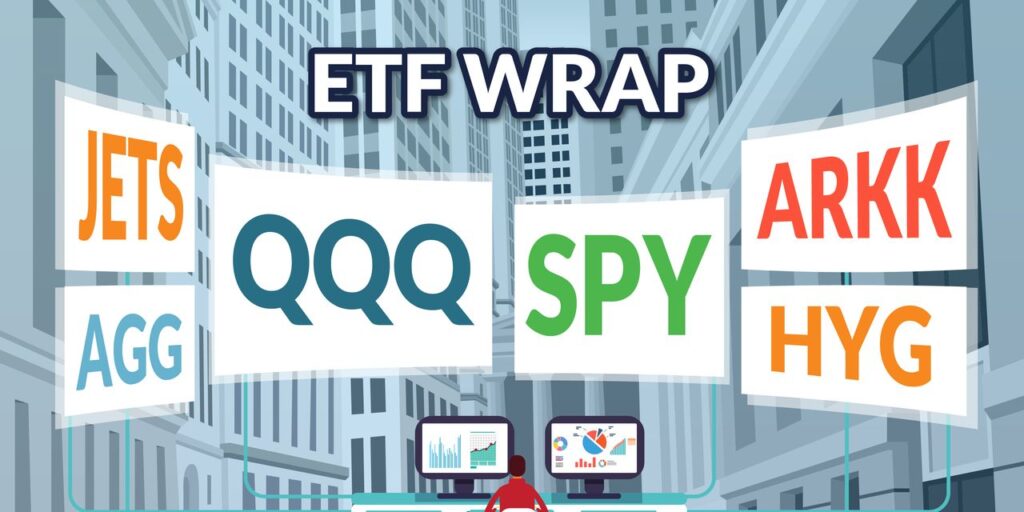Hello! For this week’s ETF Wrap, I spoke with Franklin Templeton’s Wylie Tollette on the Federal Reserve’s interest-rate decision and caught up with State Street’s Michael Arone on his midyear ETF market outlook.
Please send feedback and tips to [email protected] or [email protected]. You can also follow me on Twitter at @cidzelis and find me on LinkedIn. Isabel Wang is on Twitter at @Isabelxwang.
Sign up here for our weekly ETF Wrap.
The Federal Reserve delivered a hawkish reminder on Wednesday that it may not be done raising interest rates after deciding to pause in June, leaving investors midway through 2023 still facing rate volatility and a slowdown in U.S. economic growth.
The Fed’s pause in rate hikes looks like it may wind up being part of a slowing of the torrent pace of increases seen last year, rather than halt before a pivot to rate cuts.
The central bank’s so-called “dot plot” showing a forecast of rate projections this year was “a little bit more restrictive than we had anticipated,” said Wylie Tollette, chief investment officer at Franklin Templeton Investment Solutions, in a phone interview. “The market is no longer anticipating 2023 rate cuts,” he said, adding that “we thought the market was being too optimistic about rate cuts this year.”
The Fed’s summary of economic projections, released Wednesday, showed central bank officials’ forecasts point to potentially two more interest hikes totaling a half percentage point in 2023. That would lift the Fed’s benchmark rate from a current targeted range of 5% to 5.25% in an effort to bring down still high inflation.
In its midyear outlook for ETFs, State Street Global Advisors said the “range of potential market outcomes has never been wider,” making portfolio diversification “more important than ever.” For the second half of 2023, State Street said to consider moving up in quality in U.S. stocks and rotating overseas, balancing risks with bond ETFs, and looking at areas like gold
GC00,
to diversify recession risks.
There’s “a wider than normal potential range of outcomes” for markets as the Fed continues fighting high inflation, said Michael Arone, chief investment strategist for the U.S. SPDR business at State Street Global Advisors, in a phone interview. State Street is suggesting that “investors be prepared for a little bit of everything.”
Within bonds, “we still have a preference for shorter duration, high-quality investments with high yield,” he said. “They tend to have lower volatility compared with longer-duration assets” and interest-rate volatility has been “very high.”
Meanwhile, investors in short-duration fixed-income securities can get yields of 4.5% to 5.5% without taking on too much interest-rate and credit risk, he said.
In its midyear outlook, State Street recommended the SPDR SSGA Ultra Short Term Bond ETF
ULST,
as an investment opportunity. The fund has posted a total return of 2.1% so far this year through Wednesday, according to FactSet data.
Still, “if you have too many short-maturity fixed income investments, you have reinvestment risk, and you need to balance that as those investments mature,” according to Arone.
To extend duration, State Street suggested in its report the SPDR Portfolio Mortgage Backed Bond ETF
SPMB,
which provides exposure to agency mortgage-backed securities of the U.S. investment-grade bond market. “You get a yield pick-up relative to Treasurys yet it’s a very high credit quality instrument,” Arone said of agency mortgage-backed securities.
Arone also pointed to the SPDR DoubleLine Total Return Tactical ETF
TOTL,
as a midyear investment idea as it’s an actively managed fund that can help manage elevated bond uncertainty. The active fund can be “nimble” in adapting to market changes, he said.
Fed-funds futures traders on Thursday saw a 67% probability of a quarter-percentage-point rate hike in July and largely expected no rate cuts from current levels by year-end, according to the CME FedWatch Tool, at last check.
Investors have worried for months that the Fed’s aggressive rate-hiking cycle aimed at battling high inflation risks triggering a U.S. recession. The central bank has raised its benchmark rate by five percentage points from near zero in March 2022.
Fed Chair Jerome Powell said Wednesday during his press conference that the pace of monetary tightening has been moderating from a string of hikes last year as large as three quarters of a percentage point each. Rate increases earlier this year slowed to quarter-point hikes, before the the Fed paused them at its meeting that concluded Wednesday.
See: Fed skips June interest-rate hike, but points to two more increases this year
“It seemed to us to make obvious sense to moderate our rate hikes as we got closer to our destination,” said Powell. “So the decision to consider not hiking at every meeting, and ultimately to hold rates steady at this meeting, I would just say it’s a continuation of that process.”
Meanwhile, the economy has been resilient considering the low unemployment rate in the U.S., which stood at 3.7% in May, and the rapid pace of monetary tightening since early last year.
“It will take time, however, for the full effects of monetary restraint to be realized, especially on inflation,” Powell said during the press conference “The economy is facing headwinds from tighter credit conditions for households and businesses, which are likely to weigh on economic activity, hiring, and inflation,” he said. “The extent of these effects remains uncertain.”
Recession?
“My view is that a recession in 2023 isn’t likely,” said Arone, who expects that an economic contraction is more probable in the second quarter of 2024.
In U.S. stocks, he said State Street favors a “move up in quality” but cautions to be “mindful” about price. That’s because quality companies look “a bit expensive, in our opinion,” after outperforming this year, according to Arone.
But he said he likes the S&P High Yield Dividend Aristocrats Index tracked by the SPDR S&P Dividend ETF
SDY,
The fund represents a “good opportunity,” said Arone, as “every company in this index has increased its dividend for 20 consecutive years or more.” That suggests the ETF provides exposure to companies with stable earnings, healthy balance sheets and lots of cash flow, he said.
Franklin Templeton’s Tollette also likes stocks with a “quality bias,” citing the Franklin U.S. Large Cap Multifactor Index ETF
FLQL,
as an example of a fund that leans into quality as a “predominant factor.”
State Street’s midyear report cited the SPDR MSCI USA Strategic Factors ETF
QUS,
which has a quality and value bias, among its investing ideas for the second of 2023, along with two funds that provide international exposure, the SPDR Portfolio Developed World ex-US ETF
SPDW,
and SPDR Portfolio Europe ETF
SPEU,
Meanwhile, gold may help diversify risks of an economic downturn, according to the State Street report, which cites the SPDR Gold Shares
GLD,
and SPDR Gold MiniShares Trust
GLDM,
as ways to gain exposure to the yellow metal.
Historically, “gold has done a very good job during recessions,” said Arone.
As usual, here’s your look at the top- and bottom-performing ETFs over the past week through Wednesday, according to FactSet data.
The good…
| Top Performers | %Performance |
|
KraneShares Global Carbon Strategy ETF KRBN, |
8.9 |
|
VanEck Semiconductor ETF SMH, |
6.5 |
|
iShares Semiconductor ETF SOXX, |
6.4 |
|
Invesco China Technology ETF CQQQ, |
5.8 |
|
First Trust Nasdaq Semiconductor ETF FTXL, |
5.8 |
| Source: FactSet data through Wednesday, June 14. Start date June 8. Excludes ETNs and leveraged products. Includes NYSE, Nasdaq and Cboe traded ETFs of $500 million or greater. |
…and the bad
| Bottom Performers | %Performance |
|
Quadratic Interest Rate Volatility & Inflation Hedge ETF IVOL, |
-4.5 |
|
VanEck Junior Gold Miners ETF GDXJ, |
-3.7 |
|
abrdn Physical Platinum Shares ETF PPLT, |
-3.6 |
|
ETFMG Prime Junior Silver Miners ETF SILJ, |
-3.3 |
|
iShares U.S. Healthcare Providers ETF IHF, |
-3.3 |
| Source: FactSet data |
New ETFs
-
Simplify Asset Management said June 14 that it launched the Simplify Market Neutral Equity Long/Short ETF
EQLS,
-0.73% ,
which uses a proprietary machine-learning model for stock selection. -
Armada ETF Advisors announced on June 13 the launch of the Private Real Estate Strategy via Liquid REITs ETF
PRVT,
-1.26% ,
an actively managed fund that invests in publicly traded real-estate investment trusts and mortgage-backed securities that “correspond with the fundamental characteristics of a select group of industry-leading nontraded REIT funds.” -
Defiance said June 12 that it launched the Defiance Pure EV ETF
EVXX,
+0.81% ,
which targets “pure exposure” to electric-vehicle manufacturers.
Weekly ETF reads
Read the full article here













